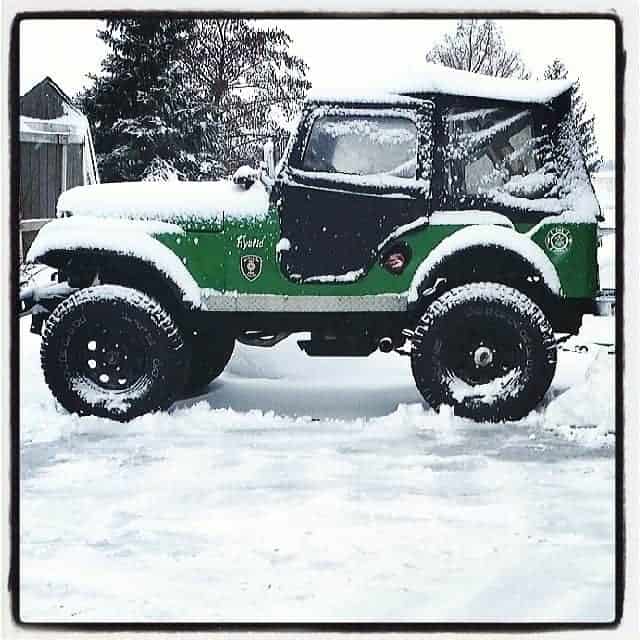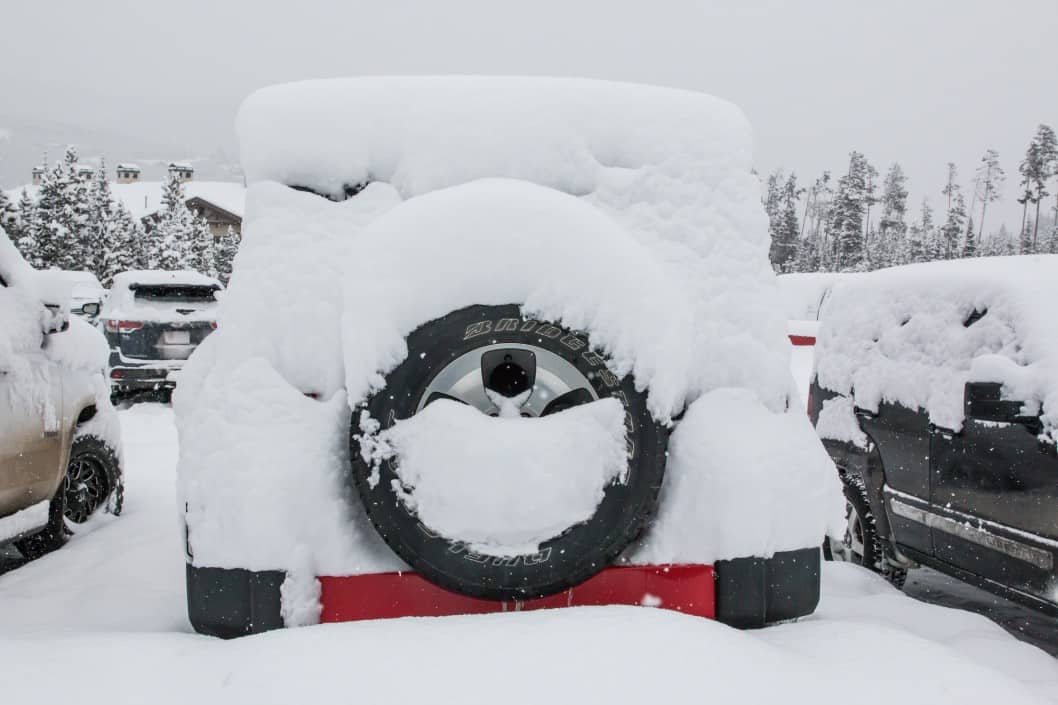Are Jeep Wranglers Cold In The Winter?
If you are afraid that a Jeep Wrangler is going to be too cold for comfort in the wintertime, that is a legitimate fear. Thankfully, that fear would be unfounded.
While it may seem strange that a Jeep Wrangler, a vehicle that isn’t as air-tight as most on the market, would come with a great heating system, it is actually quite notorious for getting you nice and toasty, and quickly!
This isn’t a new feature mind you, Jeep Wranglers have always been famous for their ability to get you nice and warm. And, while this has always been the case, they actually have added even more new heating features to newer years of Jeep Wranglers that we will discuss a bit more in-depth.
Are Jeep Wranglers Cold In The Winter?
So, the short answer is, no, Jeep Wranglers are not cold in the winter. Due to their fast and efficient heating systems, Jeep Wranglers keep drivers and passengers nice and warm in the wintertime.
If you want to know more about how a Jeep Wrangler gets nice and warm so quickly and easily, and learn about some of the new features that make a Jeep Wrangler warm in the winter, keep on reading.
This article will tell you everything you need to know, including how to make your Jeep Wrangler even warmer.
Why is A Jeep Wrangler Heating System So Great?
A Jeep Wrangler’s heating system is based on a heater core. The heat that pumps out when you turn the heat on is actually collected from the cooling system. It kinda looks like a little radiator under the hood of your Jeep Wrangler, actually.
Heated up fluid from the cooling system runs through the heater core and produces hot air around it. That hot air is then sucked up and by the blower motor and used to heat up the cabin.
The blower motor provides motion to the air and pushes it through the ventilation system in your Jeep Wrangler. When you increase the airflow, you are increasing the rotations per minute of the blower motor.
What Used Jeep Wranglers Have Heat?
YJ, TJ, JK, and JL models of Jeep Wranglers all have heating systems. So, by years, anything 1987 or newer will have a heating system.
While the front passenger and driver are sure to be nice and toasty in a well-maintained used Jeep Wrangler 1987-2020, please be advised that even the newest Jeep Wranglers have a bit of a bare-bones set up in the rear cabin when it comes to having vents for the HVAC.

What Heating Features Does a New Jeep Have?
The newest Jeeps 2019-2020 in the more upgraded trims have some extra features that are sure to keep you happy in the winter.
These features include heated seats and a heated steering wheel. While many cars have heated seats these days, a heated steering wheel to keep your hands nice and warm takes this to a whole new level.
If you are looking to buy a new Jeep Wrangler to take through wintery conditions, you can’t go wrong with upgrading your trim package to include these features.
How Do a Soft Top and a Hard Top Compare in the Winter?
A Hard Top Jeep Wrangler is going to be more airtight, and for this reason, it will always stay a bit warmer in the winter than a Soft Top Jeep Wrangler.
However, there are many Jeep Wrangler owners with soft tops that take it out in the winter, with temperatures well below freezing, without any issues.
It is worth noting that you will want to make sure your heating system is up-to-date as winter approaches every season, particularly if you own a soft top.
See, the soft top does well in the winter and keeps your warm precisely because the heating system works so well. What a soft-top doesn’t do well is insulate you from the cold.
If you have a soft-top Jeep Wrangler with a non-working heating system, you could potentially get frostbite in a worst-case scenario as you will have the wind-chill created by being in a vehicle to contend with on top of the normal chilly winter temperatures.
However, if you prepare properly every winter, you will not have a problem driving your soft top in winter conditions.

How Do I Winterize My Soft Top?
While a tear or rip might actually feel kinda nice in the summer, that same tear could potentially make your soft top Jeep Wrangler very uncomfortable at best or deadly at worst when dealing with winter temperatures.
While winter is coming, it is important to do a thorough check of your soft top. Look for any rips, tears, or leaks, and make sure to evaluate if the soft top fits on tightly.
Next, make sure to turn the heater on full blast and make sure it is producing heat. If not, you will want to get that fixed or fix it yourself before winter arrives.
How Do I Winterize My Hard Top?
While you might think all you need to do is check the heater if you have a hard top Jeep Wrangler, you would be wrong. While checking the heater is important, it is not the only thing on your to-do list while making your Jeep Wrangler winter-ready.
You also need to check all the seals on your hard top to ensure none of them are dry and cracked. If they are, you will need to have them repaired to make sure cold air isn’t pouring into your vehicle while you drive.
Why Is My Heater Not Working In My Jeep Wrangler?
There’s no doubt about it, a Jeep Wrangler is comfortable in the winter because of its heating system. If the system goes down, you are probably not going to have a good time driving your Jeep Wrangler in the winter.
But never fear! There are ways to check for and fix any issues you may be having with the heating system.
During the summer, you probably haven’t been using your heater very often. Unfortunately, the water and coolant in your system tends to settle a bit in the heater core while the heater isn’t in use. When this happens, it usually lends to leaks in the heater core.
When you turn your heater on to check it before winter, it is going to flush the old water and antifreeze out of the system and replace it with new fluids. This will allow you to determine if the heat is not working and also if there is a leak (you will be able to see it under your vehicle).
If the issue with your heater isn’t a leak, but it is still not working, you can check the various components in order to pinpoint where the problem lies, and potentially save some money by ordering new parts and fixing it yourself.
Thankfully, the beauty in a Jeep Wrangler’s HVAC system is in its simplicity, so if you have some knowledge of car mechanics, this should be an issue.

Components Of a Jeeps HVAC System and How to Fix Them
Here is a quick list of the different components in a Jeeps HVAC system, what they are, and how to check if they are working.
- Heater Core
This usually won’t “go bad.” If there is an issue, it is usually because of a leak. You should be able to do a quick visual inspection in order to check if there are leaks or any other damage.
- Blower Motor
A blower motor can in fact “go bad” and burn up. When this happens, no air can be cycled through the system. A quick way to check is to turn the heat on. If there is no air at all, you probably have a blower motor issue.
But beware! Before you purchase a new part and replace your blower motor, be sure to check your fuses as wiring, as those issues can cause the same symptom.
- Dampers
Dampers direct air to particular areas of your vehicle through the ventilation system. If there is air circulating, but it isn’t going equally throughout the system, there may be an issue with your dampers.
- Resistor
If the blower motor is working properly and air pressure is not an issue, but for some weird reason the fan only seems to work on certain speed settings, this is likely an issue with the resistor.
If the resistor entirely fails, there won’t be any air. So, it is important to check the blower motor and the resistor at the same time when you have no airflow in your Jeep Wrangler.
Final Thoughts on Jeep Wrangler Staying Warm In The Winter
With the proper care and maintenance, you can stay nice and toasty during the winter in a Jeep Wrangler, just like any other vehicle.
While the extra maintenance may turn some drivers away, this vehicle was built for tough-situations and is designed for drivers who don’t mind a little extra hard work and occasionally a bit of a challenge.
